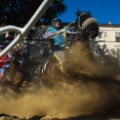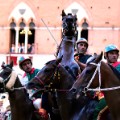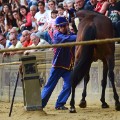Story highlights
- Race has been run since the 13th century
- Medieval festival attracts thousands
- Jockeys represent different districts of Asti
(CNN)The oldest recorded bareback horse race in Italy has been run since the 13th century -- and it's still going strong.
The Palio di Asti, which takes place on the penultimate weekend of every September, culminates in a saddle-free showdown between 21 riders representing the city's districts.
The medieval festival, which attracts thousands to Asti, a city in the northwest Piedmont region, also includes a parade involving more than 1,200 people and a flag-throwing contest.
The Palio takes its name from the Latin word pallium, which means a piece of cloth worn as cloak -- one of these was used to mark the finishing line in the earliest Asti races.
Its first recorded running was in 1275, but it has been staged in several different locations throughout the city throughout its colorful history.
Since the 1980s, the race has been run at the Piazza Alfieri on a triangular course, preceded by the blessing of the horses and their jockeys at the cathedral.
Following the flag-throwing -- which is another competition between districts -- and the dazzling parade in which medieval costumes take pride of place, racing gets going as the Palio di Asti reaches its climax in the late afternoon.
And when it's all over, the winning jockey receives a crimson banner, emblazoned with the Asti's coat of arms and the image of San Secondo, the city's patron saint.
Giovanni Atzeni, riding for the district of Nizza, was this year's winner. The 31-year-old, cheered on by a crowd of 10,000 people, headed off jockeys representing San Lazzaro and Santa Maria Nuova.







































